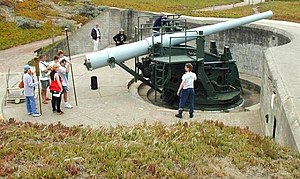6-inch gun T2
| 6-inch gun M1900 | |
|---|---|

6-inch gun M1905 on disappearing carriage M1903, Battery Chamberlin, Fort Winfield Scott, Presidio of San Francisco
|
|
| Type | Coastal artillery, Field gun |
| Place of origin | United States |
| Service history | |
| In service | 1897–1945 |
| Used by | United States Army |
| Wars | World War I, World War II |
| Production history | |
| Designer | Watervliet Arsenal |
| Designed | 1897 |
| Manufacturer | Watervliet Arsenal, possibly others |
| Variants | M1897, M1900, M1903, M1905, M1908, M1 (a.k.a. T2) |
| Specifications | |
| Weight | 19,114 pounds (8,670 kg) |
| Length | 310.4 inches (788 cm) |
| Barrel length | |
|
|
|
| Shell | separate loading, 108 pounds (49 kg) or 105 pounds (48 kg) AP shot & shell, 90 pounds (41 kg) HE |
| Caliber | 6 inch (152 mm) |
| Breech | Interrupted screw, De Bange type |
| Recoil | Hydrospring |
| Carriage |
|
| Elevation |
disappearing: 15° |
| Traverse |
disappearing: 170° (varied with emplacement) |
| Maximum firing range |
disappearing: 14,600 yards (13,400 m) |
| Feed system | hand |
disappearing: 15°
pedestal: 20°
disappearing: 170° (varied with emplacement)
disappearing: 14,600 yards (13,400 m)
pedestal: 17,000 yards (16,000 m)
The 6-inch gun M1897 (152 mm) and its variants the M1900, M1903, M1905, M1908, and M1 (a.k.a. T2) were coastal artillery pieces installed to defend major American seaports between 1897 and 1945. For most of their history they were operated by the United States Army Coast Artillery Corps. They were installed on disappearing carriages or pedestal (a.k.a. barbette) mountings, and during World War II many were remounted on shielded barbette carriages. Most of the weapons not in the Philippines were scrapped within a few years after World War II.
In 1885, William C. Endicott, President Grover Cleveland's Secretary of War, was tasked with creating the Board of Fortifications to review seacoast defenses. The findings of the board illustrated a grim picture of existing defenses in its 1886 report and recommended a massive $127 million construction program of breech-loading cannons, mortars, floating batteries, and submarine mines for some 29 locations on the US coastline. Most of the Board's recommendations were implemented. Coast Artillery fortifications built between 1885 and 1905 are often referred to as Endicott Period fortifications. The 6-inch caliber was chosen, as in many applications, for combining a relatively heavy shell with rapid hand loading. In the overall system, it was an intermediate caliber between the heavy 8-inch, 10-inch, and 12-inch weapons and the small 3-inch guns intended to defend minefields against minesweepers. The Watervliet Arsenal designed the guns and built the barrels. Initially, most of the guns were mounted on disappearing carriages; when the gun was fired, it dropped behind a concrete and/or earthen wall for protection from counter-battery fire. Within a few years, it was realized that operating the disappearing carriage negatively impacted the rate of fire, and the M1900 low-profile pedestal mount was designed.
...
Wikipedia
